Brontë

The Brontës were a 19th century literary family associated with Haworth in the West Riding of Yorkshire, England. The sisters, Charlotte (born 21 April 1816), Emily (born 30 July 1818), and Anne (born 17 January 1820), are well known as a trio of sibling poets and novelists. They originally published their poems and novels under masculine pseudonyms, following the custom of the times practised by female writers. Their stories immediately attracted attention, although not always the best, for their passion and originality. Jane Eyre, by Charlotte, was the first to know success, while Agnes Grey, then The Tenant of Wildfell Hall by Anne, and Wuthering Heights by Emily were later to be accepted as great works of literature.
The three sisters and their brother, Branwell, were very close and they developed their childhood imaginations through the collaborative writing of increasingly complex stories. The confrontation with the deaths, first of their mother, then of the two older sisters, marked them profoundly and influenced their writing.
Their fame was due much to their own tragic destinies as well as their precociousness. Since their early deaths, and then the death of their father in 1861, they were subject to a following that did not cease to grow. Their home, the parsonage at Haworth in Yorkshire, now the Brontë Parsonage Museum has become a place of pilgrimage for hundreds of thousands of visitors each year.
Origin of the name
The Brontë family can be traced to the Irish clan mac Aedh Ó Proinntigh, which literally means 'son of Aedh, grandson of Proinnteach'. Aedh is a male name derived from Aodh, meaning "fire".[1] "Proinnteach" ("the bestower") originated as a byname for a generous person. Literally meaning "banquet hall", the word is composed of the Irish proinn ("banquet") (a cognate of the Latin prandium ["meal"]) and teach ("house", "hall").[2] Ó Proinntigh was earlier anglicised as Prunty and sometimes Brunty. At some point, the father of the sisters, Patrick Brontë (born Brunty), decided on the alternate spelling with the diaeresis over the terminal e to indicate that the name has two syllables. It is not known for certain what motivated him to do so, and multiple theories exist to account for the change. He may have wished to hide his humble origins. As a man of letters, he would have been familiar with classical Greek and may have chosen the name after the cyclops Brontes (literally 'thunder'). Unrelated Bronte families are found in Sicily. The name indicates their origin from the town of Bronte.[3] In 1799 King Ferdinand IV of Naples bestowed the honour of Duke of Bronte to Lord Nelson for fighting off the French Navy.
Members of the Brontë family
Patrick Brontë
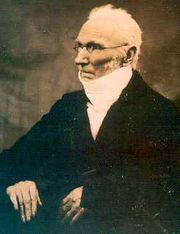
Patrick Brontë (17 March 1777 – 7 June 1861), was born in County Down, Ireland, of a very poor family of farm workers. He became the Anglican curate of the parish of Haworth, and was a poet, writer, and polemicist.
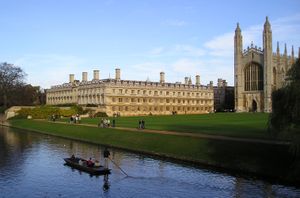
He was an Anglican priest of Irish extraction, born on St Patrick's Day 17 March 1777. He is the author of Cottage Poems (1811), The Rural Minstrel (1814), numerous pamphlets and newspaper articles, and various rural poems.[4] He had several apprenticeships until he became a teacher and moved to Cambridge where he studied theology, general subjects, and ancient and modern history.[5] Having obtained a Bachelor of Arts degree, he was ordained on 10 August 1806.[6]
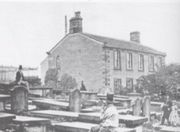
In 1812, he met and married 29 year old Maria Branwell[7][8] and by 1820 had moved into the parsonage at Haworth where he took up the post of Perpetual curate, they had six children.[9] On the death of his wife in 1821 his sister in law, Elizabeth Branwell, came to help him bring up the children. Open, intelligent, generous, and personally taking care of their education, he bought all the books and toys the children asked for and accorded them great freedom.
After several attempts to seek a new spouse, Patrick came to terms with widowhood at the age of 47, and spent his time visiting the sick and the poor, giving sermons, communion, and extreme unction,[10] leaving the three sisters Emily, Charlotte, Anne, and their brother Branwell alone with their aunt and a maid, Tabitha Aykroyd (Tabby), who tirelessly recounted local legends in her Yorkshire dialect while preparing the meals.[11] He survived his entire family, and six years after Charlotte's death, he died at the age of 84,[12]. To the end he was helped by his son-in-law, the Rev. Arthur Bell Nicholls.
Maria, née Branwell
Patrick's wife Maria Brontë, née Branwell, (15 April 1783 – 15 September 1821), originated from Penzance, Cornwall and came from a comfortably well off middle class family. Her father had a flourishing tea and grocery store and had accumulated considerable wealth.[13] Maria died at the age of 38, probably from cancer of the stomach. She married the same day as her younger sister Charlotte, in the church at Guiseley, after her fiancé had celebrated the union of two other couples.[14] She was known for her lively spirit, joyfulness and tenderness, and it was she who designed the samplers that are on display in the museum, and had them embroidered by her children. She left memories with her husband and with Charlotte, the oldest surviving sibling, of a very vivacious woman at the parsonage. The younger ones, particularly Emily and Anne, admitted to retaining only vague images of their mother, especially of her suffering in her sickbed.
Elizabeth Branwell
Elizabeth Branwell (2 December 1776 – 29 October 1842) arrived from Penzance in 1821, after the death of Maria, her younger sister, to help Patrick look after the children, and was known as 'Aunt Branwell'.
The children
Patrick and Maria Brontë had six offspring:
Maria, the first of the Brontë children, was born in Clough House, High Town on 23 April 1814, died at the age of eleven in Haworth on 6 May 1825. She suffered hunger, cold, and privation at Cowan Bridge School, as well as the tyranny of the older pupils and the mantras of the teachers on being damned to eternity and the flames of Hell (fire and brimstone).[15] She returned with an advanced case of tuberculosis. Charlotte, especially, describes her as very lively, very sensitive, and particularly advanced in her reading and in her leisure .
Elizabeth (1815–1825), the second child, joined her sister Maria at Cowan Bridge where she suffered the same fate. Elizabeth was less vivacious than her brother and her sisters, and apparently less advanced for her age. However, her premature death could not foretell what her future would have been, had she been able to cultivate the intellectual and studious passions of her family. She died on 15 June 1825 within two weeks of returning home to her father.[16]
Charlotte, born in Thornton near Bradford, West Riding of Yorkshire on 21 April 1816, was a poet and novelist and is the author of Jane Eyre, her most well known work, and three other novels. She died on 31 March 1855 just before reaching the age of 39.
Patrick Branwell was born in Thornton on 26 June 1817. Known as Branwell, he was a painter, writer and casual worker. He became addicted to alcohol and laudanum and died at Haworth on 24 September 1848 at the age of 31.
Emily Jane, born in Thornton, 30 July 1818, was a poet and novelist. She died in Haworth on 19 December 1848 at the age of 30. Wuthering Heights was her only novel.
Anne, born in Thornton on 17 January 1820, was a poet and novelist who died at the age of 29. She wrote a largely autobiographical novel entitled Agnes Grey. Her second novel, The Tenant of Wildfell Hall (1848) was far more ambitious. She died on 28 May 1849 in Scarborough, North Riding of Yorkshire.
Education
Cowan Bridge School
In 1824, the four girls entered Cowan Bridge School,[17] which educated the children of less fortunate members of the clergy, and which had been recommended to Mr Brontë.[N 1] The following year, Maria and Elizabeth fell gravely ill and were removed from the school, but died shortly afterwards within a few weeks of each other on 6 May and 15 June 1825.[18] Charlotte and Emily were also withdrawn and returned to Haworth. The loss of their sisters was a trauma that showed in Charlotte's writing. In Jane Eyre, Cowan Bridge becomes Lowood, the pathetic figure of Maria is represented by the character of the young Helen Burns, the cruelty of the mistress Miss Andrews by that of Miss Scatcherd, and the tyranny of the headmaster, the Rev. Carus Wilson, by that of Mr Brocklehurst.
Tuberculosis, which afflicted Maria and Elizabeth in 1825, was the cause of death of the surviving Brontës, who died one after the other: Branwell in September 1848, Emily in December 1848, Anne eight months later in May 1849, and finally Charlotte in 1855.
Miss Wooler's school
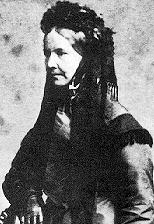

In 1831, 14-year-old Charlotte was enrolled at the school of Miss Wooler in Roe Head, Mirfield. Patrick could have sent his daughter to a less costly school in Keighley nearer home but Miss Wooler and her sisters had a good reputation and he remembered the building which he passed when strolling around the parishes of Kirklees, Dewsbury, and Hartshead-cum-Clifton where he was vicar. Margaret Wooler showed fondness towards the sisters and she accompanied Charlotte to the altar at her marriage.[19][20] Patrick's choice of school was excellent - Charlotte was happy there and studied well. She made many lifelong friends, in particular the calm and dignified Ellen Nussey and the more fanciful Mary Taylor who later went to New Zealand before returning to England.[21] Charlotte returned from Roe Head in June 1832, missing her friends, but happy to rejoin her family.[22]
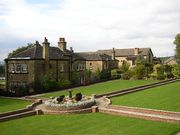
Three years later, Miss Wooler offered her former pupil a position as her assistant. The family decided that Emily would accompany her to pursue studies that would otherwise have been unaffordable. Emily's fees were partly covered by Charlotte's salary. Emily was 17 and it was the first time she had left Haworth since leaving Cowan Bridge. On 29 July 1835, the sisters left for Roe Green. The same day, Branwell wrote a letter to the Royal Academy of Art in London, to present several of his drawings as part of his candidature as a probationary student.[23]
Charlotte taught, without being particularly kind to the students she described in her notes, as she would later do in Brussels with even more sarcasm. Emily did not settle and after three months she seemed to decline and had to be taken home to the parsonage. Anne took her place and stayed until Christmas 1837.[24]
Charlotte avoided boredom by following the development of Angria which she received in letters from her brother. During holidays at Haworth, she wrote long chapters while being reproached by her father who wanted her to become more involved in parish affairs. These were coming to a head over the imposition of the Church rates, a local tax levied on parishes where the majority of the population were dissenters. In the meantime, Miss Wooler moved to Heald's House, at Dewsbury Moor, where Charlotte complained about humidity that made her unwell. She left the establishment in 1838 after receiving The Vision of Don Roderick and Rokeby, a collection of poems by Walter Scott, as a leaving present from Miss Wooler,[25]
Literary evolution
The children became interested in writing novels from an early age, initially as a game which later matured into a passion. Although they all displayed a talent for narrative, it was the younger ones whose pastime it became to develop them. At the centre of the children's creativity were twelve wooden soldiers which Patrick Brontë gave to Branwell at the beginning of June 1826.[26] These toy soldiers instantly fired their imaginations and they spoke of them as the little men, and gave them names. However, it was not until December 1827 that their ideas took written form,[27] and the novel Glass Town, set in London, Paris, and Babylonia, came into existence,[28] followed by the fictional kingdoms of Gondal, ruled by a woman, created by Emily and Anne, after the departure of Charlotte in 1831, and Angria.[29] These stories were written in several hundred little books, the size of a matchbox, (about 1.5 x 2.5 inches (3.8 x 6.4 cm)),[29] and cursorily bound with thread. The pages were filled with close, minute writing, often in capital letters without punctuation and embellished with illustrations, detailed maps, schemes, landscapes, and plans of buildings, created by the children according to their specialisations. The complexity of the stories matured as the children's imaginations developed, fed by reading the three weekly or monthly magazines to which their father had subscribed,[26] or the newspapers that were bought daily from John Greenwood's local news and stationery store.
Literary and artistic influence
These fictional worlds were the product of fertile imagination fed by reading, discussion, and a passion for literature. Far from suffering from the negative influences that never left them and which were reflected in the works of their later, more mature years, the Brontë children absorbed them with open arms. The children's symbiosis ensured that these influences were mutual and even if they had not all read the same authors, their lively discussions guaranteed that each one was kept up to date with every new cultural contribution. The family possessed a virtual library, not one on shelves, for most of the books were borrowed, but one in the form of the notes they took and the items they kept in memory. It was easy to ask for information or for a reference or even a citation. Someone always knew the answer, and they asked each other without fear of creating confusion.
The press
The periodicals that Patrick Brontë subscribed to were a mine of information for his children. The Leeds Intelligencer, Blackwood's Edinburgh Magazine, conservative and well written, but better than the Quarterly Review that defended the same political ideas whilst addressing a less refined readership, (the reason why Mr Brontë did not read it);[30] were exploited in every detail, and Blackwood's Magazine in particular, was not only the source of their knowledge of world affairs, but a map of Africa published in it in July 1831, interested them immediately because it confirmed their world of Glass Town which they had situated in West Africa.[31] Their knowledge of geography was completed by Goldsmith's Grammar of General Geography of which there was a copy at the parsonage.[32]
Lord Byron
The Brontë children rapidly diverged from the Manichean form of these stories to a more Byronic style where heroes who have a strong sexual magnetism and passionate spirit demonstrate arrogance and even black-heartedness. Again, it is in Blackwood's Magazine in August 1825 that they discover Byron, who died the previous year, for the first time. From this moment, the name Byron became synonymous with all the prohibitions and audacities as if it had stirred up the very essence of the rise of those forbidden things.[33] Branwell and Charlotte thus pushed Zamorna, one of the heroes of the Verdopolis, towards an increasingly ambiguous behaviour,[34] and the same influence and evolution recur with Emily Brontë, especially in the characters of Heathcliff in Wuthering Heights, and Mr. Rochester in Jane Eyre, who display the traits of a Byronic hero. Numerous other works have left their mark on the Brontës; namely the Thousand and One Nights for example, which inspired Jinn in which they became themselves in the centre of their kingdoms, while adding a touch of exoticism.
John Martin
The children's imagination was also influenced by three prints of engravings in mezzotint by John Martin around 1820. Charlotte and Branwell made copies of the prints Belshazzar's Feast, Déluge, and Joshua Commanding the Sun to Stand Still upon Gibeon (1816), which hung on the walls of the parsonage.[35]
Martin's fantastic architecture is reflected in Glass Town and Angria, where he appears himself among Branwell's Juvenilia[36] and under the name of Edward de Lisle, the greatest painter and portraitist of Verdopolis ,[37] the capital of Glass Town. One of Sir Edward de Lisle's major works, Les Quatre Genii en Conseil, is inspired by Martin's illustration for John Milton's Paradise Lost.[38] Together with Byron, John Martin seems to have been one of the artistic influences essential to the Brontës' universe.[35]
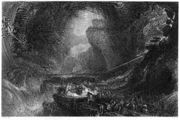
Anne's morale and realism
The influence revealed by Agnes Grey and The Tenant of Wildfell Hall is much less clear:. Anne's works are largely founded on her experience as a governess and on that of her brother's decline. Furthermore, they demonstrate her conviction, a legacy from her father, that books should provide moral education.[39] This sense of moral duty and the need to record it, are more evident in The Tenant of Wildfell Hall, written after the death of Branwell.[40] The influence of the gothic novels of Ann Radcliffe, Horace Walpole, Gregory "Monk" Lewis and Charles Maturin is noticeable,[41] and that of Walter Scott too, if only because the heroine, abandoned and left alone, resists not only by her almost supernatural talents, but mainly due to the power drawn from her temperament.
Other influence
Jane Eyre, Agnes Grey, then The Tenant of Wildfell Hall, Shirley, Villette and even The Professor present a linear structure concerning a character who advances through life after several trials and tribulations, to find a kind of happiness in love and virtue, recalling the works of religious inspiration of the 17th century such as John Bunyan's Pilgrim's Progress or his Grace abounding to the Chief of Sinners.[42] In a more profane manner, the hero or the heroine follows a picaresque itinerary such as in Miguel de Cervantes (1547–16), Daniel Defoe (1660–1731), Henry Fielding (1707–1764) and Tobias Smollett (1721–1771). This lively tradition continued into the 19th century with the from rags to riches genre that have illustrated almost all the grand Victorian romancers. The protagonist is thrown by fate into poverty and after many difficulties, achieves a golden happiness. Often an artifice is employed to effect the passage from one state to another such as an unexpected inheritance, a miraculous gift, grand reunions, etc.[N 3] and in a sense, it is the route followed by Charlotte's and Anne's protagonists, even if the riches they won were more ones of the heart than ones of the wallet. Apart from its Gothic elements, Wuthering Heights moves like a Greek tragedy and possesses its music,[43] the cosmic dimensions of the epics of John Milton, and the power of the Shakespearian theatre.[44] One can hear the echoes of King Lear as well as the completely different characters of Romeo and Juliet.[45] The Brontë were also seduced by the writings of Walter Scott, and in 1834 Charlotte exclaimed, "For fiction, read Walter Scott and only him - all novels after his are without value." [46]
Governesses, and Charlotte's idea
An alternative: governess or school mistress
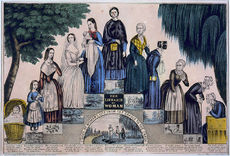
The Brontës hardly had any contact with the local population outside the circle of intimate family friends, and the quest was for what a woman could do who is not rich, but who nevertheless does not belong to the working class, but is dedicated to the work in the fields and to become a servant. Through the influence their father and their own intellectual curiosity, they were able to benefit from an education that placed them among knowledgeable people, but Mr Brontë's emoluments were modest. The only options open to the girls were either that of an honest marriage, even if it had to be one of convenience - a solution they wished to avoid, or a choice between the professions of school mistress or governess. After their failed attempt to found a school, they felt obliged to find positions in families educating often rebellious young children, or to seek employment as school teachers. The possibility of becoming a paid companion to a rich and solitary woman would have been a fall-back role, and with which she would be bored listless. Janet Todd's Mary Wollstonecraft, a revolutionary life mentions the predicament,[47] and none of the Brontë girls seems to have considered a similar eventuality.

Alone, Emily never became a governess, and her only professional experience would be an experiment in teaching during six months of exile which she could not stand, in the school of Miss Patchett at Law Hill near Halifax.[48] In contrast, Charlotte had teaching positions in the school of Miss Margaret Wooler, and in Brussels with the Hegers. She became governess to the Sidgwicks, the Stonegappes, and the Lotherdales where she worked for several months in 1839, then with Mrs White, at Upperhouse House, Rawdon, from March to September 1841.[49] Anne became a governess and worked for Mrs Ingham,[50] at Blake Hall, Mirfield from April to December 1839, then for Mrs Robinson at Thorp Green Hall, Little Ouseburn, near York, where she also obtained employment for her brother in an attempt to stabilise him; an exercise which however, turned into a disaster.[51]
Forced to become governesses
The family's finances did not flourish, and Aunt Branwell spent the money with caution. Emily had a visceral need of her home and the countryside that surrounded it, and to leave it would cause her to her to languish and wither.[N 4][52] Charlotte and Anne, being more realistic, did not hesitate in finding work and from April 1839 to December 1841 the two sisters had several posts as governess. Not staying long with each family, their employment would last just several months or the length of one season. However, Anne did stay with the Robinsons in Thorp Green where things went well, from May 1840 to June 1845.
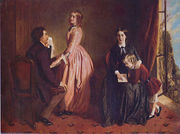
In the meantime, Charlotte had an idea that would place all the advantages on her side. On advice from her father and friends, she thought that she and her sisters had the intellectual capacity to create a school for young girls in the parsonage where their Sunday School classes took place. It was agreed to propose the future pupils the opportunity of correctly learning living languages, and that this should be prepared in situ, which led to a further decision. Among the possibilities Paris and Lille were considered,[53] but were rejected due to aversion to the French. Indeed, the French revolution and the Napoleonic wars had not been forgotten by the Tory spirited and deeply conservative girls.[54] On the recommendation of a pastor based in Brussels,[55] and who wanted to be of help, which he does several times by hosting boarders in his family.[56] Belgium was chosen, where they could also study German, and music.
School project and study trip to Brussels
Role of Elizabeth Branwell

Elizabeth Branwell who raised the children after the death of their mother,[12] was a Methodist. It seems, nevertheless, that her denomination did not exert any influence on the children. It was Aunt Branwell who taught the children arithmetic, the alphabet, how to sew,[57] embroidery and cross-stitching appropriate for ladies. Aunt Branwell also gave them books and subscribed to Fraser's Magazine, less interesting than Blackwood's, but, nevertheless, providing plenty of material for discussion.[58]
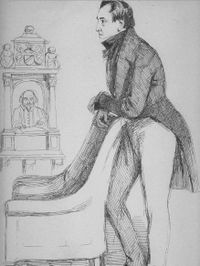
She was a generous person who dedicated her life to her nieces and nephew, neither wanting to marry nor to return to visit her relations in Cornwall, and she provided the funds for the project in Brussels.
Charlotte's and Emily's journey to Brussels
Emily and Charlotte arrived in Brussels in February 1842 accompanied by their father.[59] Once there, they enrolled at Monsieur and Madame Heger's boarding school in the Rue d'Isabelle, for six months. Claire Heger was the second wife of Constantin, and it was she who founded and directed the school while Constantin had the responsibility for the higher French classes. According to Miss Wheelwright, a former pupil, he had the intellect of a genius. He was passionate about his auditorium, demanding many lectures, perspectives, and structured analyses.[60] He was also a good-looking man with regular features, bushy hair, very black whiskers, and wore an excited expression while sounding forth on great authors about whom he invited his students to make a pastiche on general or philosophical themes.[61][62]
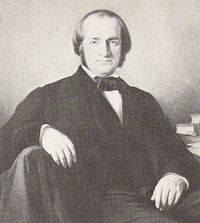
The lessons, especially those of Constantin Heger, were very much appreciated by Charlotte, and the two sisters showed exceptional intelligence, although Emily hardly liked her teacher and was somewhat rebellious.[61] Emily learned German and to play the piano with natural brilliance, and very quickly the two sisters were writing literary and philosophical essays in an advanced level of French. After six months of studying, Mme Heger suggested they stay at the boarding school free of charge, in return for giving some lessons. After much hesitation, the girls accepted. Neither of them felt particularly attached to their students, and only one, Mademoiselle de Bassompierre, then aged 16, later expressed any affection for her teacher, which appeared to be mutual for Emily, and made her a gift of a signed, detailed drawing of a wind-blown/storm ravaged(tn) pine tree.[63]
Return and recall
The death of their aunt in October of the same year forced them to return once more to Haworth. Aunt Branwell had left all her worldly goods in equal shares to her nieces and Eliza Kingston, a cousin in Penzance,[64] which had the immediate effect of purging all their debts and providing a small reserve of funds. Nevertheless, they were asked to return to Brussels as they were regarded as being competent and were needed. They were each offered teaching posts in the boarding school, still English for Charlotte and music for Emily. However, Charlotte returned alone to Belgium in January 1843,[65] while Emily remained critical of Monsieur Heger, in spite of the excellent opinion he held of her. He later stated that she 'had the spirit of a man', and would probably become a great traveller due to her being gifted with a superior faculty of reason that allowed her to deduce ancient knowledge of new spheres of knowledge, and her unbending willpower would have triumphed over all obstacles. [66]
Vexed, Charlotte returns
Almost a year to the day, enamoured already for some time of Monsieur Heger, Charlotte resigned and returned to Haworth. Her life there had not been without suffering, and on one occasion she ventured into the cathedral and entered a confessional. She may have had intention of converting to Catholicism, but it would only have been for a short time.[67]
Life at Haworth became more difficult after she had left. Mr Brontë lost his sight although his cataract had nevertheless been operated on with success in Manchester, and it was there in August 1846,[68] when Charlotte arrived at his bedside that she began to write Jane Eyre, and her brother Branwell fell into a rapid decline punctuated by dramas, drunkenness, and delerium.[69] Due partly to Branwell's poor reputation, the school project failed and was abandoned.[70]
Charlotte wrote four long, very personal, and sometimes vague letters to Monsieur Héger, that never received replies. The extent of Charlotte Brontë's feelings for Heger were not fully realised until 1913, when her letters to him were published for the first time. Heger had first shown them to Mrs. Gaskell when she visited him in 1856 while researching her biography The Life of Charlotte Brontë, but she concealed their true significance. These letters, referred to as the 'Heger Letters', had been ripped up at some stage by Heger, but his wife had retrieved the pieces from the wastepaper bin and had meticulously glued or sewn them back together. Paul Heger, Constantin's son, and his sisters, gave these letters to the British Museum,[62][71] and they were shortly after printed in The Times newspaper.[72]
The Brontë sisters' literary career
First publication : Poems, by Currer, Ellis and Acton Bell
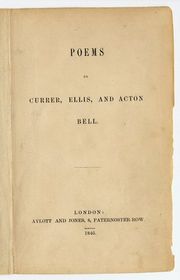
The writing that had begun so early never left the family. Charlotte had the ambition like her brother (though Branwell was kept at a distance from her project) and wrote to the poet laureate Robert Southey to submit several poems of his style; she received an hardly encouraging reply after several months. Southey, still illustrious although his star has somewhat waned, was one of the great figures of English Romanticism, with William Wordsworth and Samuel Taylor Coleridge, and shared the prejudice of the times: literature was considered a man's business, and not an appropriate occupation for ladies.[73]
However, Charlotte did not allow herself to be discouraged. Furthermore, coincidence came to her aid. One day in autumn 1845 while she was alone in the dining room she noticed a small notebook lying open on in the drawer of Emily's portable writing desk and of my sister Emily's handwriting. She read it and was dazzled by the beauty of the poems that she did not know. The discovery of this treasure was what she recalled five years later, and according to Juliet Barker, she erased the excitement that she had felt,[74] more than surprise […], a deep conviction that these were not common effusions, nor at all like the poetry women generally write. I thought them condensed and terse, vigorous and genuine. To my ear, they had a peculiar music - wild, melancholy, and elevating. In the following paragraph Charlotte describes her sister's indignant reaction at her having ventured into such an intimate realm with impunity. It took Emily hours to calm down and days to be convinced to publish the poems.[75]
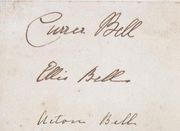
Charlotte envisaged a joint publication by the three sisters. Anne was easily won over to the project, and the work was shared, compared, and edited.[76] Once the manuscripts had been chosen, ten for Charlotte and twenty-one each for Anne and Emily, Charlotte went about searching for a publisher. She took advice from William and Robert Chambers of Edinburgh, directors of one of their favourite magazines, Chambers's Edinburgh Journal. It is thought, although no documents exist to support the claim, that they advised the girls to contact Aylott & Jones, a small publishing house at 8, Paternoster Row, London, who accepted but rather at the authors' own risk as they felt the commercial risk to the company was too great.[77] The work thus appeared in 1846 under the masculine pseudonyms of Currer (Charlotte), Ellis[78] (Emily) and Acton (Anne) Bell. These were very uncommon forenames but the initials of each of the sisters were preserved and the patronym could have been inspired by that of the vicar of the parish, Arthur Bell Nicholls. It was in fact on 18 May 1845 that he took up his duties at Haworth, at the moment when the publication project was well advanced.
The book attracted hardly any attention. Only three copies were sold of which one was purchased by Fredrick Enoch, a resident of Cornmarket, Warwick, who in admiration, wrote to the publisher to request an autograph - the only extant single document carrying the three author's signatures in their pseudonyms,[79] and they continued creating their prose, each one producing a book a year later. The three girls always worked in secret,[80] unceasingly discussing their writing for hours at the dinner table, after which their father would open the door at 9 p. m. with Don't stay up late, Girls!, then rewinding the clock and taking the stairs to his room upstairs.[81]
Fame
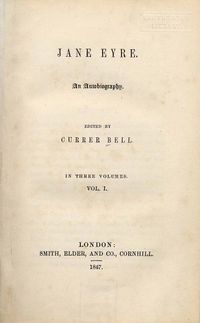
1847, a bountiful year
Charlotte's Jane Eyre, Emily's Wuthering Heights, and Anne's Agnes Grey, appeared in 1847 after many tribulations, again for reasons of finding a publisher. The packets containing the manuscripts often retuned to the parsonage and Charlotte simply added a new address and did this at least a dozen times during the year.[82] The first one was finally published by Smith, Elder & Co in London, of which the 23-year-old owner George Smith had been specialised until then in publishing scientific revues aided by his perspicatious reader, William Smith Williams and remained faithful to the family. Those of Emily and Anne were confided to Thomas Cautley Newby who intended to compile a three-decker, more economical for sale and for loan in the circulating libraries the two first volumes to include Wuthering Heights and the third one Agnes Grey. Both the novels attracted critical acclaim, occasionally harsh about Wuthering Heights, praised for the originality of the subject and its narrative style, but viewed with suspect because of its outrageous violence and immorality - surely, the critics wrote, a work of a man with a depraved mind [83] - fairly neutral about Agnes Grey, more flattering in spite of certain commentators denouncing it as an affront to morals and good mores,[84] for Jane Eyre which soon became what would be called today a bestseller.
Jane Eyre and the end of anonymity
The anonymous (Currer Bell) publication in 1847 of Jane Eyre, An Autobiography, established a dazzling reputation for Charlotte. In July 1848, Charlotte and Anne (Emily had refused to go along with them) travelled by train to London to prove to Smith, Elder & Co that each sister was indeed an independent author, for Thomas Cautley Newby, the publisher of Wuthering Heights and Agnes Grey, had launched a rumour that the three novels were the work of one author, understood to be Ellis Bell (Emily). George Smith was extremely surprised to find two gawky, ill-dressed country girls paralysed with fear, who, to identify themselves, held out the letters addressed to Messrs. Acton, Currer and Ellis Bell. Taken by such surprise, he introduced them to his mother with all the dignity their talent merited, and invited them to the opera for a performance of Rossini's Barber of Seville.[85]
The powerful winds of Wuthering Heights
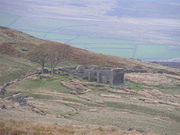
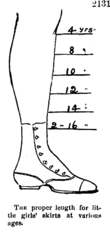
Emily Brontë's, Wuthering Heights, was published in 1847 under the masculine pseudonym Ellis Bell, by Thomas Cautley Newby, in two companion volumes to that of Anne's (Acton Bell), Agnes Grey. Controversial from the start of its release, its originality, its subject, narrative style, and troubled action raised intrigue. Certain critics condemned it,[86] but sales were nevertheless considerable for a novel from an unknown author and which defied all conventions.
It is a work of black Romanticism; covering three generations isolated in the cold or the spring of the countryside with two opposing elements: the dignified manor of Thrushcross Grange and the rambling dilapidated pile of Wuthering Heights. The main characters, swept by tumults of the earth, the skies, and the hearts, are strange and often possessed of unheard of violence and deprivations. The story is told in a scholarly fashion, with two narrators, the traveller and tenant Lockwood, and the housekeeper/governess, Nelly Dean, with two sections in the first person, one direct, one cloaked, which overlap each other with digressions and sub-plots that form, from apparently scattered fragments, a coherently locked unit.
1848, Anne's second novel
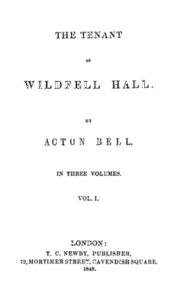
One year before her death in May 1849, Anne published a second novel. Far more ambitious than her previous novel, The Tenant of Wildfeld Hall was, like Agnes Grey, a simple but tormented slice-of-life story about a young governess faced with a morgue of great earthly bourgeois, and is based on her own personal experience, though indirectly this time for it concerned the decline of her brother Branwell.
The master theme is the alcoholism of a man who causes the downfall of his family. Helen Graham, the central character, gets married for love to Arthur Huntingdon, whom she soon discovers to be lecherous, violent, and alcoholic. She is forced to break with the conventions that keep her in the family home that has become hell, and to leave with her child to seek secret refuge in the old house of Wildfell Hall. When the alcohol causes the final demise of her husband, she returns to care for him in total abnegation until his death.
Charlotte Brontë

The struggle: denunciation of boarding schools (Jane Eyre)
Considering the times of the episode of Cowan Bridge, where Maria and Elizabeth contract the tuberculosis from which they die several weeks after returning home, the school's system was probably no more and no less severe than that of any other comparable establishment. In many ways it could even be considered to have been somewhat milder. Nevertheless, Charlotte denounced it for its strictness, its lack of cleanliness, the rotten food, and the hunger that tormented her, the repeated vomitings and above all those of her sister, the forced taking of emetics, the blood-lettings, the negligence of the doctor who was none other than the director's brother-in-law, and the low fever epidemic (probably typhus), the barbaric severity of the punishments, and the wickedness of several members of the teaching staff, in particular that of Miss Andrews.[87] Several dozen years earlier the Austen sisters Jane and Cassandra, had caught typhus during their school years, almost causing the death of Jane. Their education, like that of the Brontë sisters, was continued at home.[88]
These conditions that modern norms of hygiene and well-being would qualify as dysfunctional, were considered normal at the time and furthermore, when Mrs Gaskell's book was published, a great polemic shook the kingdom and different protagonists got caught up in a relentless war.[89] It is therefore appropriate to be grateful for the perspicacity of Mr Brontë and his courage to have taken the decision, a difficult one from the point of view of his family and his profession without offending the hierarchy, to remove his daughters from the school to which he had sent them in good faith.[90] This withdrawal was certainly too late for the two oldest, but he could be forgiven for not having been aware of the state of their health.
Literary encounters
Following the success of Jane Eyre, Charlotte was pressured by George Smith, her publisher, to start travelling, above all to London (she also went with him to Edinburgh) where in spite of the extreme timidity that made her almost incapable of expressing herself other than in monosyllables,[91] she was highly acclaimed and introduced to great writers of the era. She was thus able to get to know Harriet Martineau who later invited her to her house, The Knoll, in Ambleside in the Lake District where she was a neighbour of William Wordsworth.
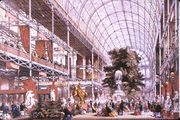
She was very interested in Thackeray for whom she demonstrated a great admiration and whose portrait, given to her by George Smith, hung in the dining room at the parsonage.[92] At one of these presentations to an audience of literary notables, after a short sketch Thackeray announced Charlotte's entrance with great pomp under the name of Jane Eyre. Furious and mortified, she took the great man aside, and arming herself with courage, harshly lectured him that neither her dignity as a woman nor her qualities as an author would permit him to make such amalgamations. Thackeray was a very tall man and Charlotte was a very small woman of hardly more than 4 feet 7 inches (1.4 m) - exactly 4 feet 9 inches (1.448 m) according to the dimensions taken by the carpenter who made her coffin. Certain witnesses report having seen their silhouettes through the windows of the room and that Charlotte with her head tilted back to look straight into the eyes of her interlocutor, looked like an angry hen.[93]
During her trip to London in 1851 she visited the Great Exhibition and The Crystal Palace.[94] In 1853 she published Shirley and in 1849 Villette.
Marriage and death
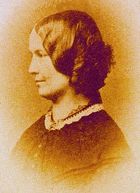
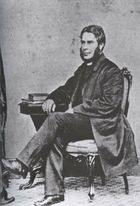
The Brontë sisters were highly amused by the behaviour of the vicars they met. Arthur Bell Nicholls (1818–1906) had been vicar of Haworth for seven and a half years when contrary to all expectations he proposed to Charlotte. Although impressed by his dignity and deep voice, she found him rigid, conventional, and rather narrow minded 'like all the vicars' - she wrote to Ellen Nussey.[95] She declined his proposal and began a busy period during which Nichols, pursued by the anger of Patrick Brontë, left his functions for several months.[96] However, little by little her feelings evolved and after slowly convincing her father, she finally married Nichols on 29 June 1854.[97]
On return from their honeymoon in Ireland where she had been introduced to her parents-in-law, her life completely changed. She adopted her new duties as a wife that take up most of her time, she wrote to her friends telling them that Nicholls was a good and attentive husband, but that she nevertheless felt a kind of holy terror at her new situation. In a letter to Ellen Nussey (Nell), in 1854 she wrote Indeed-indeed-Nell-it is a solemn and strange and perilous thing for a woman to become a wife.[98]
The following year she died aged 39. The cause of death given at the time was tuberculosis, but it may have been complicated with typhoid fever, the water at Haworth being so contaminated from the lack of any sanitation and the vast cemetery that surrounded the church and the parsonage, and her pregnancy that was in its early stage.[99]
The first biography of Charlotte was written by Elizabeth Cleghorn Gaskell at the request of Patrick Brontë, and published in 1857, helping to create the myth of a family of condemned genius, living in a painful and romantic solitude. After having stayed at Haworth several times and having accommodated Charlotte in Plymouth Grove, Manchester, and become her friend and confidant, Mrs Gaskell had certainly had the advantage of knowing the family well.[100]
Novels
- Jane Eyre : An Autobiography (1847).
- Shirley (1849).
- Villette (1853)
- The Professor (1857)
Unfinished fragments
These are outlines or unedited roughcasts which with the exception of Emma have been recently published.
- Ashford, written between 1840 and 1841, where certain characters from Angria are transported to Yorkshire and are included in a realistic plot.
- Willie Ellin, started after Shirley and Villette, and on which Charlotte worked relatively little in May and July 1853, is a story in three poorly linked parts in which the plot at this stage remains rather vague.
- The Moores is an outline for two short chapters with two characters, the bothers Robert Moore, a dominator, and John Henry Moore, an intellectual fanatic.
- Emma, already published in 1840 with an introduction from Thackeray. This brilliant fragment would doubtlessly have become a novel of similar scope to her previous ones.[101]
- The Green Dwarf published in 2003. This story was probably inspired by The Black Dwarf by Walter Scott of whose novels Charlotte was a fan. The novel is a fictional history about a war that breaks out between Verdopolis (the capital of the confederation of Glass Town) and Senegal.[102]
Branwell Brontë
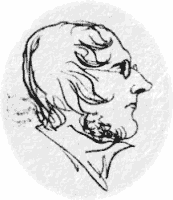
Patrick Branwell Brontë, (1817–1848), was considered by his father and his sisters to be a genius. On the other hand, the book by Daphne du Maurier (1986), The Infernal World of Branwell Brontë, contains numerous references to his addiction to alcohol and laudanum. He was an intelligent boy with many talents and interested in many subjects especially literature. He was often the driving force in the construction of the imaginary worlds. He was artistic and encouraged by his father to pursue this.
Whilst trying to make a name as an artist, he left for London but in several days used up the allowance provided by his father in cafés of ill repute.[103][104] His attempts to obtain low paid work failed,[105][106] and very quickly he foundered in alcohol and laudnum and was unable to regain his stability.[107]
Anne Brontë obtained employment for him in January 1843, but a month later he was dismissed.[108][109] In September 1848 after several years of decline he died from tuberculosis. On his death, his father tearfully repeated 'My brilliant boy', while the clear headed and totally loyal Emily, wrote that his condition had been 'hopeless'.[110]
Branwell is the author of Juvenilia, which he wrote as a child with his sister Charlotte, Glass Town and Angria, poems, pieces of prose and verse under the pseudonym of Northangerland,[N 5] such as Real Rest published by the Halifax Guardian on 8 November 1846[111] from several articles accepted by local newspapers and from an unfinished novel probably from around 1845 entitled And the Weary are at Rest.[112]
Emily Jane Brontë
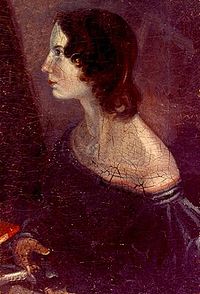
Emily Jane Brontë (1818–1848) has been called the Sphynx of Literature, writing without the slightest desire for fame, and only for her own satisfaction. She was obsessively timid outside the family circle to the point of turning her back on her partners in conversation without saying a word.[113]
With a single novel, Wuthering Heights and poems of an elementary power, she reached the heights of literature. Almost unknown during her life, posterity classes her as 'top level' in the literary canon[114][N 6] of English literature.
Above all, Emily loved to wander about the wild landscape of the moors around Haworth. In September 1848 her health began to decline rapidly. Consumptive, but refusing all treatment,[115] with the exception of a visit from a London doctor - because although it was already too late, her relatives insisted - she died in December on the sofa in the dining room. It is possible that she left an unfinished manuscript which was burned by Charlotte to avoid such controversy as followed the publication of Wuthering Heights. Several documents exist that allude to the possibility, although no proof corroborating this suggestion has ever been found.[116]
Emily Brontë's poems
Emily's poems were probably written to be inserted in the saga of Gondal, with which she identified herself with several of the characters right into her adulthood. At the age of 28 she still acted out scenes from the little books with Anne while travelling on the train to York.[117] Remembrance was one of the 21 of Emily's poems that were chosen for the 1846 joint publication before which, Emily had deleted all references to Gondal.
Anne Brontë
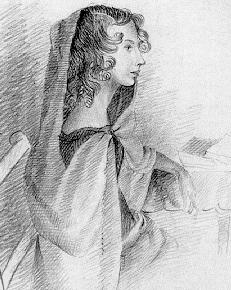
Anne was considered to be the least talented of the sisters. Thus, The Short Oxford History of English Literature writes that her first novel was overshadowed by those of Charlotte and Emily and that the narrator endures humiliation, snobbism, and incivility from her employers with a firm resolution helped along by her sense of duty and high moral conscience. The chronicle, sprinkled with Anne's own experiences, is the basis of Agnes Grey which appears to be a semi-autobiographical novel.
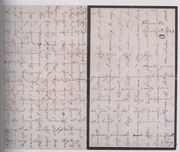
Anne's health began to decline rapidly, like that of her brother and sister some months earlier. On 5 April 1849, she wrote to Ellen Nussey asking her to accompany her to Scarborough on the east coast. Anne hoped that the sea air would improve her health, as recommended by the doctor, and Charlotte finally agreed to go.[118]
On the Sunday morning she felt weaker and asked if she could be taken back to Haworth. The doctor confirmed that she was near to death and Anne thanked him for his candour. "Take courage, take courage" she murmured to Charlotte. She died at 2 pm on Monday 18 May. She is buried in the cemetery of St Mary's of Scarborough.[119] Her gravestone carries an error in her age in the inscription because she died at the age of 29 and not at 28. It was noticed by Charlotte during her only visit, and she had the intention of asking the mason to correct it. Ill health did not leave him time to effect the repair and the tombstone has remained in the same state to this day.
Northern England at the time of the Brontës
In her 1857 biography The Life of Charlotte Brontë, Mrs Gaskell begins with two explanatory and descriptive chapters. The first one covers the wild countryside of the West Riding of Yorkshire, the little village of Haworth, the parsonage and the church surrounded by its vast cemetery perched on the top of a hill. The second chapter presents an overview of the social, sanitary, and economic conditions of the region. The following works up to the most recent: The Brontës by Juliet Barker (1994) : bound volume, 1995, :occupy a large place in these elements which in several ways have contributed to mould and create in them the extraordinary characters which they became.
Social, sanitary, and economic conditions in Haworth
The death toll within the Brontë family was not unusual and left little impression on the village population who were confronted with death on a daily basis. When Patrick Brontë arrived, the parish suffered from unemployment. The men sought work in the quarries and local handicrafts. The only businesses were the pharmacy which supplied Branwell, and John Greenwood's stationery store in which the Brontës were the best customers.
Haworth's population grew rapidly during the first half of the 18th century, from hardly 1,000 to 3,365 in 50 years.[120] The village did not have a sewage system and the well water was contaminated by faecal matter and the decomposition of bodies in the cemetery on the hill top. Life expectancy was less than 25 years and infant mortality was around 41% of children under six months of age.[121] Most of the population lived from working the poorly fertile land of the moors, and supplemented their incomes with work done at home such as spinning and weaving wool from the sheep that were farmed on the moors.[122] Conditions changed[123] and the textile industry, already present since the end of the 17th century, grew in the mills on the banks of the River Worth, whose waters turned the wheels which consequently required fewer people to work them.
Food was scarce, often little more than porridge, resulting in vitamin deficiencies. Public hygiene was non-existent and lavatories were basic. The facilities at the parsonage were no more than a plank across a hole in a hut at the rear, with a lower plank for the children. In her thirties, Charlotte was described as having a toothless jaw, by such persons as Mrs Gaskell, who stated in a letter dated 25 August 1850 to Catherine Winkworth : […] large mouth and many teeth gone […].[124] However, food was reasonable in the family. Well filled plates of porridge in the morning and piles of potatoes were peeled each day in the kitchen while Tabby told stories about her country or Emily revised her German grammar, and sometimes Mr Brontë would return home from his tours of the village with game donated by the parishioners.
The role of the woman
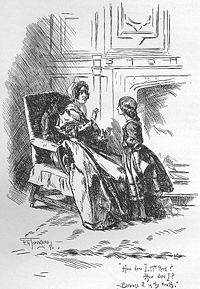
According to Robert Southey, poet laureate, in his response to Charlotte, ladies from a good background should be content with an education and a marriage embellished with some decorative talents.[52] Mr Brontë also said to one of the characters in his The Maid of Kilarney, without one knowing whether it truly reflected a widespread opinion in order to support it or to condemn it: The education of female ought, most assuredly, to be competent, in order that she might enjoy herself, and be a fit companion for man. But, believe me, lovely, delicate and sprightly woman, is not formed by nature, to pore over the musty pages of Grecian and Roman literature, or to plod through the windings of Mathematical Problems, nor has Providence assigned for her sphere of action, either the cabinet or the field. Her forte is softness, tenderness and grace, in any case, it seemed to contradict his attitude towards his daughters whom he encouraged even if he was not completely aware of what they did with their time.[125]
Education of young girls of modest disposition
The question arose regarding the education of girls of barely middle class when they did not dispose of either significant connections or adequate funds to send them to established upper class schools. A solution was the schools where the fees were reduced to a minimum - so called charities - with a mission to come to the aid of families such as those of the lower clergy. One cannot accuse Mr. Brontë of not having done everything possible to find what he thought would be most appropriate for his daughters. As Barker comments, he had read in the Leeds Intelligencer of 6 November 1823, the reports judged by the Court of Commons in Bowes, and others judged on 24 November 1824 near Richmond, two towns in the county of Yorkshire, where pupils had been discovered gnawed by rats, and suffering from malnutrition to the extent that some of them had lost their sight.[126] Nothing was to suggest that Reverend Carus Wilson's Clergy Daughters' School of not being able to respond to his expectations. The school was not particularly cheap and its patrons (honorary members) were all respected people including the daughter of Mrs. Hannah Moore, an author of recognised works and a close friend of the eminent poet William Cowper, both proponents of a correct education for young girls, and the offspring of different prelates and even certain acquaintances of Patrick including William Wilberforce who had successfully completed their education at St. John's, thus he believed to be surrounded by all the necessary guarantees.[127]
The Brontë sisters' place in literature
Due to their forced or voluntary isolation, the Brontë sisters constituted a separate literary group which neither had predecessors nor successors. There is not a 'Brontë' line such as exists among authors of realist and naturalist novels, and in poetry, the romantic, and the symbolic.
Their influence certainly existed but it is difficult to define in its totality. Writers who followed them doubtlessly thought about them while they were creating their dark and tormented worlds such as Thomas Hardy in Jude the Obscure or Tess of the d'Ubervilles, or George Eliot with Adam Bede and The Mill on the Floss. There were also more conventional authors such as Matthew Arnold, who in a letter from 1853, says of Charlotte, that she only pretends to heartless: '[…] nothing but hunger, rebellion and rage'.[128] In contrast, Mrs Humphry Ward, author of Robert Elsmere and morality novels, only finds didactic among the works of Charlotte, while she appreciates the happy blend of romance and realism in the works of Emily.[129] There is however nothing that could constitute a literary vein.
Pilgrimages to Haworth from 1860
By 1860 Charlotte had been dead for five years and the only people living at the parsonage were Mr Brontë, his son-in-law, Arthur Bell Nicholls, and two servants. In 1857 Mrs Gaskell's biography of Charlotte was published and though Mr Brontë at its first reading approved of its commissioning, several months later he expressed doubts. The portrait of Nicholls, founded partly on the confidence of Ellen Nussey, seemed to him to be unjustified. Ellen Nussey, who hated Arthur, insists that his marital claims had perverted Charlotte's writing and that she had to struggle against an interruption of her career. It is true that Arthur found Nussey to be too close to his wife and he insisted that she should destroy her letters - although this never actually happened.[130] Mrs Gaskell's book caused a sensation and was distributed nationwide. The polemic launched by the father resulted in a squabble that only served to increase the family's fame.[131]
During Charlotte's lifetime friends, and sponsors visited the parsonage, including Sir James and Lady Kay Shuttleworth, Ellen Nussey, Elizabeth Gaskell, John Store Smith a young writer from Manchester, Bessie Parkes who recounted her visit to Mrs Gaskell, and Abraham Holroyd, poet, antiquarian, and historian.[132] However, following the publication of the book and the pastor's public remonstrations, the parsonage became a place of pilgrimage for admirers wanting to see it with their own eyes. Charlotte's husband recalled that he had to protect his father-in-law, when on the short path to the church they had to push their way through the crowds of people wanting to reach out and touch the cape of the father of the Brontë girls.[132] The hundreds of visitors became thousands, coming from all over Britain and even from across the Atlantic. Whenever he agreed to meet them, Patrick received them with utmost courtesy and recounted the story of his brilliant daughters, never omitting to express his displeasure at the opinions held about Charlotte's husband.[132]
The flow of visitors has never abated. Indeed, the parsonage at Haworth is one of the most visited places in the world.[N 7][133]
The Brontë Society
The Brontë Parsonage Museum is managed and maintained by the Brontë Society[134] which It organises exhibitions, and takes care of the cultural heritage represented by objects and documents which belonged to the family. The society has branches in Ireland, the USA, Canada, Australia, South Africa, the Scandinavian countries, and France.
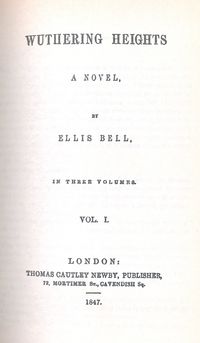
The Brontë phenomenon
In 1904, Virginia Woolf visited Haworth and published an account in The Guardian on 21 December. She remarked on the symbiosis between the village and the Brontë sisters, the fact that utensils and clothes which would normally have disappeared before those who used them, have survived, enables one to better understand their singular presence. She also wrote: Haworth expresses the Brontës; the Brontës express Haworth; they fit like a snail to its shell.[135]
The Brontës in popular culture
Cinema
- The American film Devotion 1946 by Curtis Bernhardt, constitutes a biography of the Brontë sisters. Ida Lupino plays Emily Brontë and Olivia de Havilland plays Charlotte Brontë.
- In the 1967 French film Week-end by Jean-Luc Godard, Emily Brontë appears in a scene where one of the protagonists asks for geographical information.
- Les Sœurs Brontë is a 1979 French film by André Téchiné. Isabelle Adjani plays Emily Brontë, Marie-France Pisier plays Charlotte Brontë, and Isabelle Huppert plays Anne. Patrick Magee plays Patrick Brontë, while the role of Branwell Brontë is played by Pascal Greggory.
Other
- Charlottebrontë is the name of asteroid #39427, discovered by Palomar Observatory on 25 September 1973.[136] The asteroids #39428 and #39429 (both discovered on 29 September 1973, at Palomar Observatory) are named Emilybrontë and Annebrontë respectively.
- The impact crater Brontë, is named in honour of the Brontë family, and is 60 km diameter on the surface of the planet Mercury.[137]
- Several 20th century choreographic works have been inspired by the lives and works of the Brontë sisters. Martha Graham's ballet, Death and Entrances in 1943, from which the title is taken from a poem by Dylan Thomas.
- In 1995 dancer Gillian Lynne presented a composition entitled The Brontës.
References
- Notes
- ↑ See details in the chapter Boarding schools for young ladies.
- ↑ In this letter dated 21 April 1844, the day of her 28th birthday, she thanks her friend Nell for the gift, returns the gesture by sending her some lace: "I hope" she adds "they will not peck it out of the envelope at the Bradford Post-office, where they generally take the liberty of opening letters when they feel soft as if they contained articles".
- ↑ See Oliver Twist, David Copperfield, Great Expectations, just to mention Charles Dickens
- ↑ which had happened whenever she left Haworth for any length of time such as at Miss Wooler's school, or when teaching in Law Hill, and during her her stay in Brussels.
- ↑ One of the key characters of Glass Town, Alexander Rogue, created by Branwell, finally became Earl of Northangerland.
- ↑ The place of Wuthering Heights in the literary canon is assured : see the synopsis of Wuthering Heights in the Critical commentary de Heather Glen, p. 351.
- ↑ Publications by the Brontë Society inform that the site is classed as the second most visited in the world. During a visit in 1996, the information boards at the entrance claimed over two million visitors, doubtlessly exaggerated.
- Footnotes
- ↑ Behind the Names
- ↑ Dictionary of American Family Names, Oxford University Press, ISBN 0-19-508137-4
- ↑ "Bronte". Sicilian Surnames. 24 October 2007. http://sicilia.indettaglio.it/eng/cognomi/motore/motore_sql.html?Cognome=Bronte&Modo=E.
- ↑ Banbridge, Culture Northern Ireland
- ↑ Barker 1995, pp. 3–14 (details of the education of Patrick Brontë).
- ↑ Barker 1995, p. 11, note 50.
- ↑ Barker 1995, p. 48
- ↑ Barker 1995, pp. 56–57
- ↑ Smith Kenyon 2002, p. 16
- ↑ Barker 1995, pp. 241–242
- ↑ Smith Kenyon 2002, p. 27
- ↑ 12.0 12.1 A Brief History of the Brontë Family
- ↑ Barker 1995, pp. 48–49, 52
- ↑ Barker 1995, p. 47
- ↑ Conditions of life in the Clergy Daughters' School.
- ↑ Smith Kenyon 2002, p. 25
- ↑ Nicoll, W. Robertson (1908) The Complete Poems of Emily Brontë — Introductory Essay, p. XVI.
- ↑ Barker 1995, pp. 137–139
- ↑ Barker 1995, pp. 757–758
- ↑ Nicoll, W. Robertson (1908) The Complete Poems of Emily Brontë — Introductory Essay, p. XVII.
- ↑ Barker 1995, pp. 446, 465
- ↑ Barker 1995, pp. 170–175, 181–183
- ↑ Barker 1995, pp. 224–226
- ↑ Barker 1995, pp. 235–237
- ↑ Barker 1995, pp. 238–291
- ↑ 26.0 26.1 Smith Kenyon 2002, p. 28
- ↑ David W. Harrison, The Brontes of Haworth pp. 75–76..
- ↑ Smith Kenyon 2002, p. 29
- ↑ 29.0 29.1 Smith Kenyon 2002, p. 30
- ↑ Drabble, Margaret (1985), The Oxford Companion to English literature, p. 105.
- ↑ Blondel, Jacques (1955) Emily Brontë : expérience spirituelle et création poétique (Emily Brontë, spiritual experience and poetic creation) p. 137.
- ↑ Christine Alexander, Jane Sellars,(1995) The Art of the Brontës, p. 68.
- ↑ Gérin, Winifred (1966) Byron's influence on the Brontë, Keats-Shelley Memorial Bulletin, 17.
- ↑ Christine Anne Alexander, Juliet McMaster, The child writer from Austen to Woolf, Cambridge University Press, 2005, p. 23.
- ↑ 35.0 35.1 Heather Glen, Charlotte Bronte, Oxford University Press, 2004, pp. 168–169
- ↑ Patrick Branwell Brontë, Victor A. Neufeldt, The Works of Patrick Branwell Brontë, Routledge, 1999, p. 63.
- ↑ Terry Castle, Boss Ladies, Watch Out!, Routledge, 2002, pp. 153, 158.
- ↑ Winifred Gérin, Charlotte Brontë, Oxford University Press, 1969, p. 592.
- ↑ Drew Lamonica, We are three sisters, University of Missouri Press, 2003, pp. 118, 127.
- ↑ Elizabeth Langland, Anne Brontë, Rowman & Littlefield, 1989, p. 155.
- ↑ Christopher John Murray, Encyclopedia of the romantic era, 1760-1850, Publié par Taylor & Francis, 2004, pp. 121–122.
- ↑ Robert Ferrieux (2001) La littérature autobiographique en Grande Bretagne et en Irlande (The Autobiographocal Literature of Great Britain and Ireland) chapters II and III, Paris, Ellipses,
- ↑ Sandra Hagan, Juliette Wells, The Brontės in the World of the Arts, p. 84.
- ↑ Miriam Allott, The Brontës: The Critical heritage, Routledge, 9 November 1995, ISBN 978-0415134613 p. 446.
- ↑ Sandra Hagan, Juliette Wells, The Brontės in the World of the Arts, Ashgate, September 2008, ISBN 978-0-7546-5752-1 p. 82
- ↑ Gaskell 1857, p. 104
- ↑ Todd, Janet (2000), Mary Wollstonecraft, a revolutionary life London, Weidenfeld and Nicholson, Orion House.
- ↑ Barker 1995, pp. 293–296, 306–307
- ↑ The Brontês: a brief chronology, The Brontës of Haworth, Brontë Parsonage Museum, Annexe 1.
- ↑ Barker 1995, p. 308
- ↑ Barker 1995, pp. 456–465, 469–470
- ↑ 52.0 52.1 Gaskell 1857, p. 123
- ↑ Gaskell 1857, p. 196
- ↑ Bensimon, Fabrice (2000) Les Britanniques face à la Révolution française de 1848 (The British in the Face of the French Revolution) p. 234
- ↑ Mr Jenkins, of the episcopat of Brussels Barker 1995, p. 363
- ↑ Barker 1995, pp. 82–394
- ↑ Smith Kenyon 2002, p. 17
- ↑ Barker 1995, p. 179
- ↑ Barker 1995, p. 363
- ↑ Barker 1995, pp. 414, 418
- ↑ 61.0 61.1 Nicoll, W. Robertson (1908) The Complete Poems of Emily Brontë — Introductory Essay, p. XXI.
- ↑ 62.0 62.1 du Maurier 1987, p. 240
- ↑ Barker 1995, pp. 394–395
- ↑ Barker 1995, pp. 409, 449
- ↑ Nicoll, W. Robertson (1908) The Complete Poems of Emily Brontë — Introductory Essay, p. XXIII.
- ↑ Barker 1995, p. 392
- ↑ Barker 1995, pp. 423–424, 429, 695
- ↑ Nicoll, W. Robertson (1908) The Complete Poems of Emily Brontë — Introductory Essay, p. XXVI.
- ↑ Barker 1995, pp. 544–545, 565–568
- ↑ Barker 1995, pp. 439–440
- ↑ Barker 1995, pp. 440–441, 471–472
- ↑ The Times 29 July 1913. Translated and with a commentary by Marion H. Spielmann
- ↑ Barker 1995, p. 262 : Literature cannot be the business of a woman's life, and it ought not to be. The more she is engaged in her proper duties, the less leisure will she have for it, even as an accomplishment and a recreation
- ↑ Barker 1995, p. 478
- ↑ Barker 1995, pp. 478–479
- ↑ Barker 1995, pp. 478–479, 481, 484
- ↑ Barker 1995, pp. 484–485
- ↑ Barker 1995, pp. 3–6 : it has been posited that Emily took inspiration for the names from the first name of her paternal grandmother, Eleanor McClory, often called Alice. If there is any subconscious memory, which is always possible, it is hardly likely that Emily would have wanted to pay homage to to a forebear who whom she had never known
- ↑ Barker 1995, p. 499
- ↑ their father learned of the existence of Jane Eyre after its publication and exclaimed Charlotte's published a book and it's better than likely! Barker 1995, p. 546
- ↑ Brontë Parsonage Museum: Haworth Parsonage: home of the Brontës, 1. The Entrance.
- ↑ Barker 1995, p. 503
- ↑ Barker 1995, pp. 539–542
- ↑ Barker 1995, pp. 537–539
- ↑ Smith Kenyon 2002, pp. 12–13
- ↑ Barker 1995, pp. 90, 91, 533–534, 539–540, 653–654
- ↑ Barker 1995, pp. 135–136
- ↑ Barker 1995, p. 138
- ↑ Barker 1995, pp. 801–808
- ↑ Barker 1995, pp. 119–127
- ↑ Barker 1995, pp. 643–644
- ↑ The Brontës of Haworth, Brontë Parsonage Museum, section 3, The Dining Room, illustration 5. This pencil drawing by Samuel Lawrence, is visible on this page
- ↑ Barker 1995, pp. 621, 675–678
- ↑ Barker 1995, p. 676
- ↑ Peters,Margot (1975) Unquiet Soul, p. 358.
- ↑ Peters,Margot (1975) Unquiet Soul, pp. 358–363, 378–387, 358.
- ↑ Barker 1995, p. 758
- ↑ Peters, Margot (1975) Unquiet Soul, Futura Publications, p. 400.
- ↑ Barker 1995, pp. 769–772
- ↑ Barker 1995, pp. 651–653, 681, 726–728, 738–741
- ↑ Winfritth, Tom, (1995) Charlotte Brontë, Unfinished Novels, Alan Sutton Publishing Ltd, Dover
- ↑ The Green Dwarf: A Tale of the Perfect Tense, by Brontë Charlotte, and Purves, Libby (foreword by), Hesperus Press, ISBN 9781843910480, ISBN 1843910489
- ↑ du Maurier, Daphne, (1986) The Infernal World of Branwell Brontë, pp. 49–54
- ↑ Barker 1995, pp. 226–231
- ↑ du Maurier, Daphne, (1986) The Infernal World of Branwell Brontë pp. 119–131
- ↑ Barker 1995, pp. 374–375
- ↑ Barker 1995, pp. 512–516, 543–545
- ↑ du Maurier, (1986) The Infernal World of Branwell Brontë, pp. 148–158, 160–166
- ↑ Barker 1995, pp. 334, 335, 456–469, 467–469, 492
- ↑ Barker 1995, pp. 317, 470
- ↑ Barker 1995, illustration 17 between pp. 332 and 333
- ↑ Barker 1995, pp. 334–335, 473–474, 489–490, 524
- ↑ Barker 1995, p. 198
- ↑ Heather Glen, Wuthering Height, Critical commentary, 1988, page 351]
- ↑ Robertson Nicoll, The Complete Poems of Emily Brontë — Introductory Essay, 1908, p. XXIX.
- ↑ Barker 1995, pp. 534–539
- ↑ Barker 1995, pp. 450–451
- ↑ Barker 1995, p. 591
- ↑ Barker 1995, pp. 594–595
- ↑ The Brontës of Haworth, Brontë Parsonage Museum, Haworth 1820-1861, p. 2.
- ↑ The Brontës of Haworth, Brontë Parsonage Museum, Haworth 1820-1861, p. 3.
- ↑ The Brontës of Haworth, Brontë Parsonage Museum, Haworth 1820-1861, p. 3.
- ↑ cf. the Ludditesrevolt and its consequences: Barker 1995, pp. 45–47
- ↑ Margaret Smith, Letters, volume II, letter 75, p. 447.
- ↑ Barker 1995, p. 117
- ↑ Barker 1995, p. 119
- ↑ Barker 1995, pp. 119–120
- ↑ Margaret Drabble, The Oxford Companion to English Literature, 1985, p. 134.
- ↑ Margaret Drabble, The Oxford Companion to English Literature, 1985, p. 135.
- ↑ Barker 1995, pp. 766–767, 773, 780, 790–791, 806
- ↑ Barker 1995, pp. 819–820, 822–823
- ↑ 132.0 132.1 132.2 Charles Lemon, Early Visitors to Haworth, From Ellen Nussey to Virginia Woolf, Haworth, The Brontë Society, 1996.
- ↑ David Orme, The Brontës, Evans Brothers, 1999, p. 27: Haworth is the second most visited literary site after Stratford-upon-Avon.
- ↑ Brontë Society'
- ↑ Charles Lennon, Early Visitors to Haworth, from Ellen Nussey to Virginia Woolf, 1996, pp. 124–125.
- ↑ Jet Propulsion Laboratory.
- ↑ Gunter Faure, Teresa M. Mensing, Introduction to Planetary Science, page 168 (avec une photo montrant le cratère Brontë).
- Bibliography
- Barker, Juliet R. V. (1995). The Brontës. London: Phoenix House. ISBN 1-85799-069-2.
- du Maurier, Daphne (1987) [1960]. The Infernal World of Branwell Brontë. London: Penguin Books. ISBN 0140034013.
- Gaskell, Elizabeth (1857). The Life of Charlotte Brontë.
- Smith Kenyon, Karen (April 2002). The Brontë Family: Passionate Literary Geniuses. Lerner Publications. ISBN 082250071X.
Further reading
- Alexander, Christine and Sellars, J. (1995) The Art of the Brontës, Cambridge; New York: Cambridge University Press, ISBN 0-521-43248-0
External links
|
||||||||||||||||||||